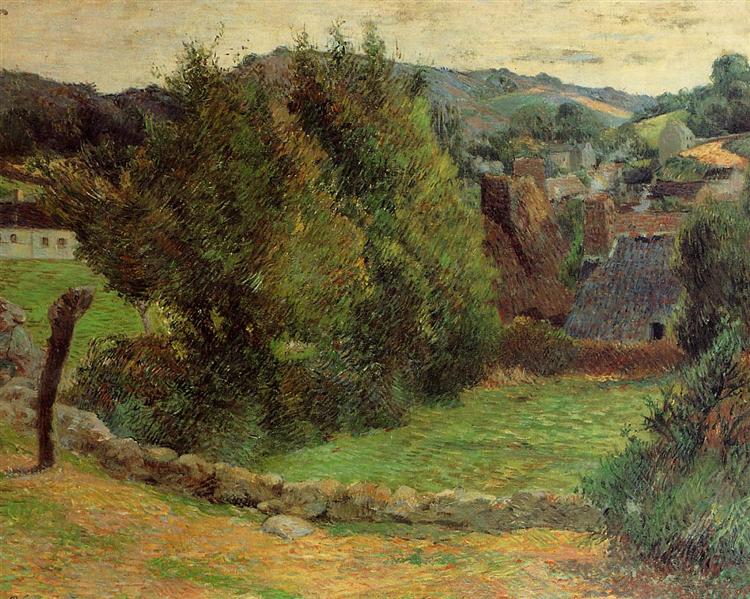Opis
Paul Gauguin's painting "Landscape at Pont-Aven", created in 1886, is a representative work of the artist's innovative approach to color and form during his early years in Brittany, a region that had a profound impact on his artistic evolution. In this piece, Gauguin captures the pastoral landscape with a unique perspective that departs from traditional naturalistic depiction, in tune with his growing interest in emotional synthesis in painting. The elements of the work revolve around the simplicity of the setting, but are charged with symbolism, providing a sense of harmony and serenity.
The composition of the painting is notable for its layered structure, where the foreground is populated by a vast area of green grass that extends into the background where gentle hills can be seen. This choice of perspective invites the viewer to immerse themselves in the landscape, promoting a visual dialogue between the observer and the environment depicted. The hills that rise on the horizon are outlined with a soft stroke that oscillates between shades of blue, green and sky blue, evoking the beauty of the Breton atmosphere. This back and forth between tones brings the landscape to life and shows Gauguin's skill in using colour as an expressive vehicle.
The use of color in “Landscape at Pont-Aven” is especially significant, as Gauguin opts for a vibrant palette that evokes the glow of natural light. Deep greens and broad blues coexist with yellow hues that fill the landscape with a luminosity that seems tactile. Through this color choice, the artist not only documents the environment, but also suggests a sense of emotion that transcends mere observation. This emphasis on color resonates with the ideas of Post-Impressionism, where color becomes a means of expressing feelings and states of soul.
It is interesting to note that in this work there are no visible human figures, which contrasts with other works by Gauguin where the inclusion of humanoid characters is more prominent. The absence of characters in "Landscape at Pont-Aven" can be interpreted as a celebration of nature in its pure state, as well as a meditation on the connection between man and the natural world. In this way, the landscape takes on a life of its own, becoming a protagonist that invites contemplation.
In the context of Gauguin's work, this canvas can be seen as a crucial stage in his artistic career. By 1886, Gauguin was beginning to distance himself from the conventions of Impressionism in order to explore his own personal expression. This shift is evident not only in Landscape at Pont-Aven, but in other contemporary works where the focus on form and colour reveals a desire to capture not only the external appearance of reality, but also its inner essence.
When confronted with this work, the viewer is confronted with a clear example of how Gauguin used his time in Brittany to forge a unique style that would influence later generations of artists. The work attests to the transformation of the landscape into a deeply personal form of artistic expression, where every stroke and every tone seems to speak not only of the physical world, but also of the human experience. This work, with its apparent simplicity, stands as a monument to the search for color and form, a search that continues to resonate in the realm of contemporary art. Thus, “Landscape at Pont-Aven” is not merely a representation of a place, but a visual statement of the poetry of the landscape itself.
KUADROS ©, a famous painting on your wall.
Hand-made oil painting reproductions, with the quality of professional artists and the distinctive seal of KUADROS ©.
Painting reproduction service with satisfaction guarantee. If you are not completely satisfied with the replica of your painting, we will refund 100% of your money.

